|
|
|
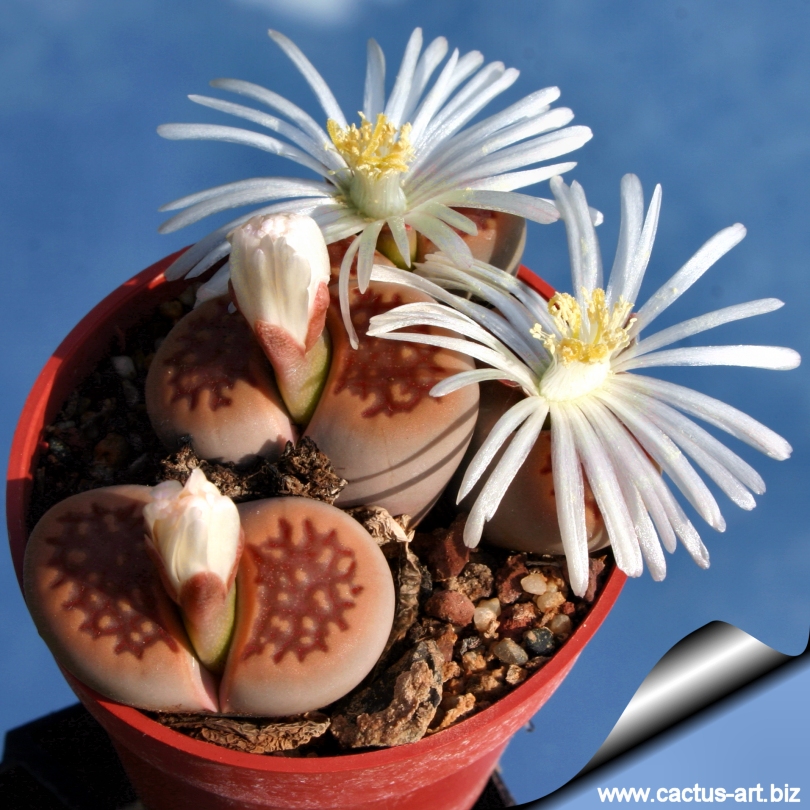
Lithops hallii ochracea C59
This is a beautiful plant
with a very striking brick-red colour.
|
|
Description: L.
hallii is one of the most variable white flowering species with
broadly kidney shaped leaves pairs.
This species shows shades of reddish-brown with
regular fine to broad interlacing network of channels.
Flowers:
The blooms are white 20-45 mm in diameter.
Fruits:
6-loculed capsules.
Seeds:
light yellow-brown
to yellow-brown, smooth to rugose.
Lithops hallii
comprises several more or less intergrading and distinct
variety:
- var. hallii
H.W.De Boer 1957. Cole numbers:
C022, C045, C050, C052, C090, C094, C119, C158, C174, C176, C318,
C375; (Brown Form)
C135, C136; (Syn: L. salicola
reticulata) C087
Truncate in outline, top surface
usually flat, medium sized about 20 to 40 mm broad, fissure shallow,
4-7 mm; lobes conjunct. It forms forms small groups with 2-3 (or more)
heads.
Face slightly rugose with fairly distinct margins and relatively
uniform and fairly easy to identify for its
fine network of channels with mostly
small regular islands, windows occluded to open with scattered dots,
dashes and hooks in the windows and channels. Margins often toothed
and clearly distinct. Shoulders, margins, islands greyish, pastel to
pale brow with shadows of yellow, pink, blue, green, orange or reddish
brown.
- var. ochracea
(H.W.
de Boer) D.T. Cole 1962.
Cole
numbers: C039, C059, C098,
C111, C142A, C303, C372
The names comes from the Latin for “ochre-coloured” (reddish) for its
more red-brown colouration: Profile boat shaped, diameter of the face
about 20-30 mm. Margins distinct regular to somewhat dentate sometimes
with a few peninsulas. Channels regular more or less broad. Islands
regular and small with scattered dots, dashes and hooks, occasionally
with some longer lines forming a broken network. Shoulders, margins
and islands, milky pink, beige, or orange or pinkish grey. Windows and
channels greenish, red-brown, reddish blue, orange-brown, or brownish
grey. Rubrications bright to dull blood-red or orange-red.
Cultivars:
-
Lithops halli cv''
Green Soapstone' (1985) C111 The plant is yellowish-green in
colour, but is otherwise the same as var. hallii. This nice cultivars
derives from only two green specimens found in habita Margins and
islands opaque milky greenish-yellow. Windows and channels various
shades of opaque dull greenish brown or greyish brown. Shoulders pale
greyish green.
|
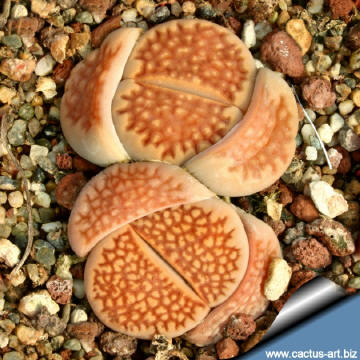 |
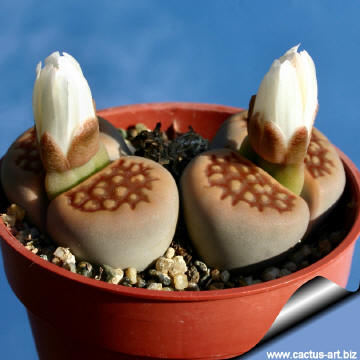 |
|
|
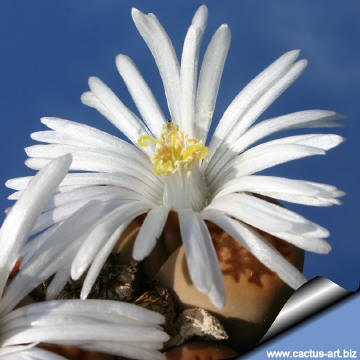 |
 |
|
|
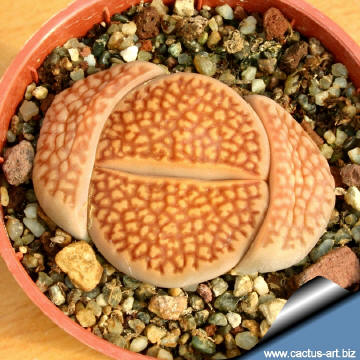 |
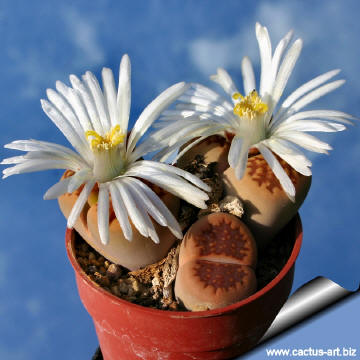 |
|
Advertising
|
|
|
|
|
Family: Mesebrianthemaceae (Aizoaceae)
Scientific name:
Lithops
hallii var. ochracea
(H.W. de Boer) D.T.
Cole 1962
Origin: Repubblic of
South Africa, Cape province
TL: Near Upington, on a low ridge, in
quartz (C059).
Habitat:
L. halli v. ochracea
grows on a stony soil comprising pegmatite, quartzite, calcrete,
jaspillite and quartzs feldspar.
Colours of the backgrounds
grey-white, white, pink
with some red, brown and black.
Conservation status:
Listed in
CITES appendix 2.
Etymology: Named after
Harry Hall who collect this plant in April 1956.
The species names
comes from the Latin
"ochra"
for
“ochre-coloured”
(reddish)
for its red-brown colouration.
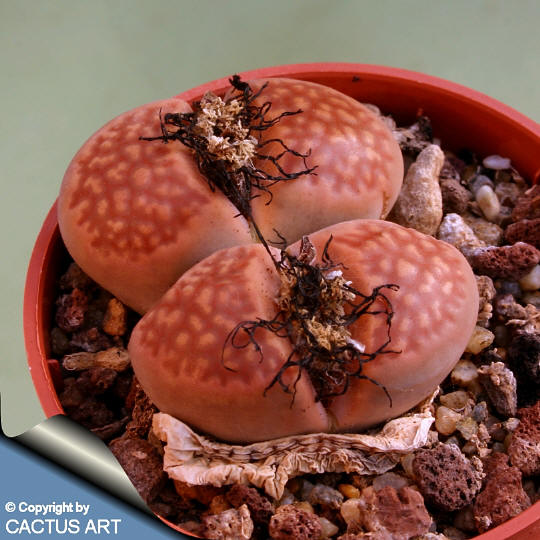
|
|
|
|
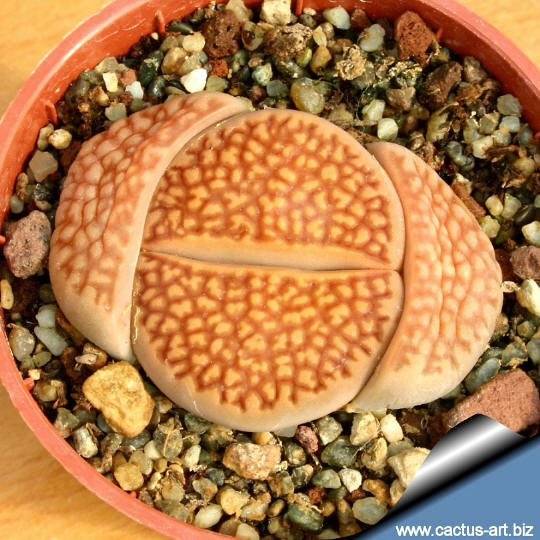
Remarks: Lithops are partly
subterranean, with only the clear 'window'
in each leaf tip exposed above soil. A type of optical system exists
whereby a layer of apical tissue rich in calcium oxalate crystals acts
as a filter to intense sunlight before it reaches the thin
chlorophyllous layer below. They are also called
mimicry plants as they show a striking similarity to their
background rocks and are difficult to detect when not in flower. These
are the commonly known as pebble plants or living stones; each species
is associated with one particular type of rock formation and occurs
nowhere else. Its soil-embedded, subterranean growth form also reduces
the need for chemical defences against herbivores.
Cultivation: Need an open mineral, fast
draining mix and the maximum amount of light you are able to give them.
The basic cultivation routine is: Stop watering after flowering. Start
watering after the old leaves completely dry. (Usually late March or
Early April) Water freely during the growing season, soak the compost
fully but allow it to dry out between waterings,
no water when cold. Some growers fertilize
frequently, some hardly ever. Keep them dry during the winter. Nearly
all problems occur as a result of
overwatering and poor ventilation especially when weather
conditions are dull and cool or very humid. This plant is best for a well lit area (Bright
shade to
full sun). But don't be afraid even
the best growers have plants that mysteriously dry up, or leave during
the night.
Note: After flowering in the
autumn and extending through
winter
season the plant doesn’t need
watering, but they will still be
growing, the new
bodies will be increasing in size extracting
water from the outer
succulent leaves, allowing them to
shrivel away. In fact the plant in this time extracts
water and
nutrient stored in the outer
succulent leaves, allowing them to
dehydrate relocating the water to the rest of the plant and to
the new leaves that form during this period until the old leaves are
reduced to nothing more than "thin papery shells".
Improvement of
lithops characteristics: Some growers (but not all!!) think it is
very intriguing to reinforce any
characteristic of cultivated Lithops of by crossing two similar selected
plants and then back-crossing with the mother plant. This way we can
eventually get some interesting results. Of course, many of the nicest
Lithops we grow in cultivation have already been selected over time.
However many Lithops are already nice plants which can’t really be
improved, on the other hand one could try to improve the colour or the
markings etc. Now if we have two particular plants we may attempt to
breed between them and can maybe get a whole improved population and
then select some better offspring to continue the selection.
Photo of conspecific taxa, varieties, forms and
cultivars of Lithops Hallii

 |
|